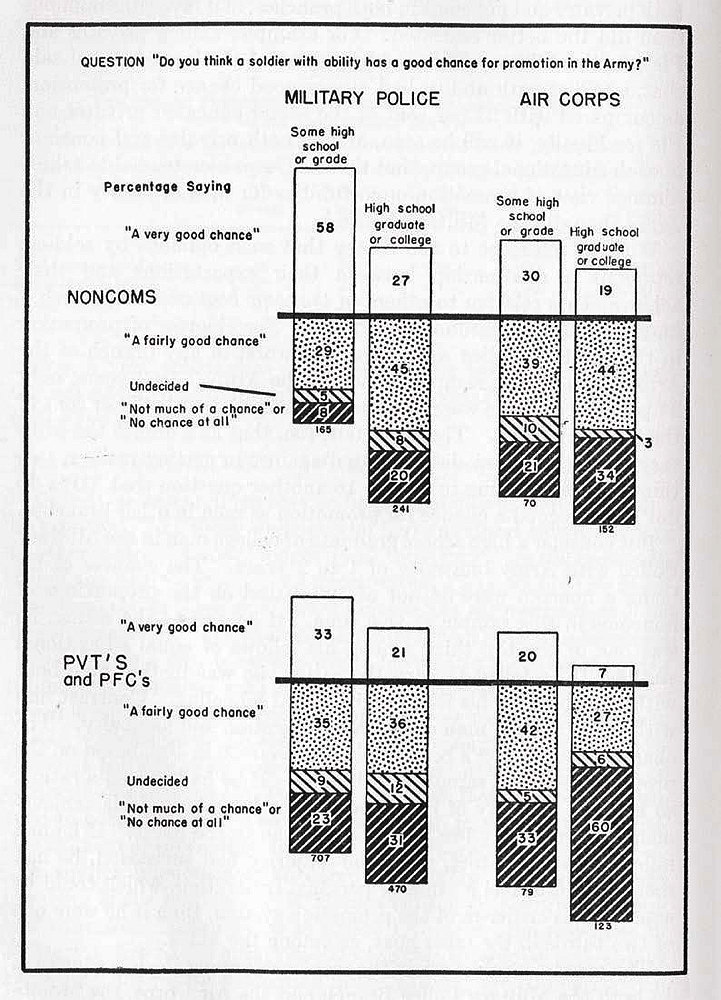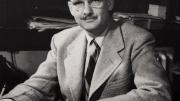During world war ii, when Samuel Stouffer led the research branch of the U.S. Army’s information and education division, the hundreds of surveys he directed on the attitudes of American soldiers were radical innovations. Despite the strong support of his boss, General Frederick Osborn, who knew FDR personally and had other social connections useful for bureaucratic leverage, the research branch endured a precarious status. Old-line senior officers were shocked that academic types wanted to use questionnaires to ask GIs’ opinions of officers’ leadership abilities. They feared morale surveys might put rebellious ideas into soldiers’ heads—for example, that orders could be questioned.
Stouffer had to prove the value of social research to these skeptics. When an early survey indicated that conscripts hated spit-and-polish basic training, including close-order drill, he and his colleagues obtained permission to run an experiment. They designed a conditioning program based on college-coaching methods, and then a sample of GIs assigned to the new program was compared with a sample assigned to traditional basic training. Comparative morale studies, as well as before-and-after tests of strength and endurance, showed that the new approach put men in better physical condition faster—and also reduced griping about the training. That report, read by senior War Department officers, not only led to a change in the methods used by the army to improve the stamina of recruits, it also convinced some generals of the utility of social research.

Chart IX, reprinted from The American Soldier (volume 1, Adjustment During Army Life, page 253; Princeton University Press, 1949), by Stouffer and four colleagues. The wealth of data collected during World War II, reflected in charts such as this one, led Stouffer to insights that included relative deprivation.
In 1946, with a reputation as a world-class survey researcher, Stouffer arrived at Harvard as professor of sociology and director of the Laboratory of Social Relations, bringing his army data along. He analyzed those data for The American Soldier, a two-volume study that developed insights relevant for human behavior generally, including a concept he called “relative deprivation.” He began with a chart (left) that revealed anomalous replies from a probability sample of enlisted men asked, “Do you think a soldier with ability has a good chance for promotion in the army?” Air-corps members were more pessimistic than military police about their prospects; better-educated soldiers were more pessimistic than poorly educated troops. This seemed counterintuitive: better-educated soldiers and air-corps troops were actually more likely to be promoted. Stouffer deduced that educational superiority and Air Corps membership gave some soldiers higher expectations for promotion than actually occurred. Other sociologists then applied this concept to explain, for example, why poor people in rich societies commit more crimes than those in poor societies, even though objectively they are better off.
Stouffer was a leading figure in the new social relations department, an amalgam of sociology, anthropology, clinical psychology, and social psychology when breaking down boundaries among social-science disciplines seemed a wonderful idea whose time had come. Partly because of the department’s reputation, partly because of his own reputation and congeniality, he served on strategic committees, advised senior administrators, and designed surveys as needed. A small-town Iowa background did not hinder his gaining powerful admirers in sophisticated Cambridge, including Harvard’s provost, Paul Buck, and president, James Bryant Conant. The two were listening to the 1948 election returns together when Harry Truman’s upset victory was announced. “When you see Sam [Stouffer] tomorrow, tell him not to be discouraged,” Conant told Buck. Explosions occur in the lab, the chemist-turned-president added. “They are most embarrassing, but they don’t end chemistry.”
Stouffer, in fact, had not predicted a winner in the presidential race. But days after the election, the president of the Social Science Research Council (SSRC) sought his help in dealing with the black eye that survey research risked, given so many top pollsters’ erroneous predictions. Despite his heavy schedule, Stouffer saw it as his professional obligation to help explain what had happened. In 1949, he and Duncan MacRae Jr. contributed a chapter to an SSRC monograph that examined the evidence, overlooked or ignored by the professional pollsters, of a last-minute swing to Truman, and urged greater caution about inferring election-day behavior from polls taken during a campaign. Polls are good at describing current beliefs or behavior, they noted, but not as reliable for predicting future behavior.
Stouffer continued to be in demand, fielding calls from the Bureau of the Census, the SSRC, the Russell Sage Foundation, and sociology department chairmen elsewhere. Early in August 1960, he was hard at work planning an international study for the Population Council on obstacles to reducing fertility rates—another chance for social research to show what it could do, by contributing to a solution for overpopulation. Lung cancer—he had been a heavy smoker—took him first. Earlier that year, he had assembled a selection of his papers for publication, not realizing they were to be his final statement to the profession. He chose an appropriate title, Social Research to Test Ideas, and carefully selected a favorite Shakespearean quotation to open the book, to draw attention to the value of skepticism:
Glendower: I can call spirits from the vasty deep.
Hotspur: Why, so can I, or so can any man; But will they come when you do call for them? (Henry IV, part 1, act 3, scene 1)
Stouffer was not interested in research to learn about trivia. He always insisted that the payoff of data collection was the opportunity to understand what was going on.









